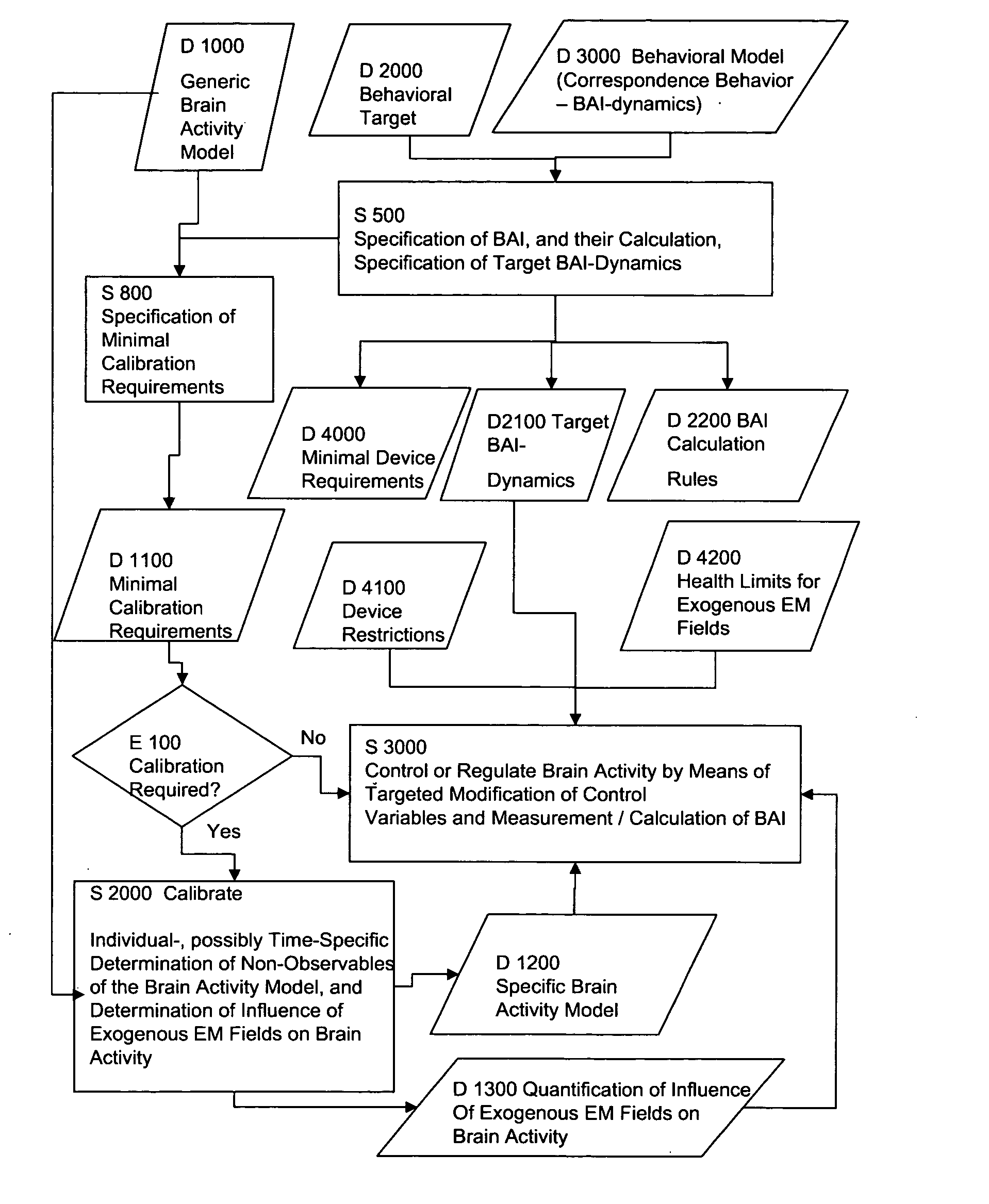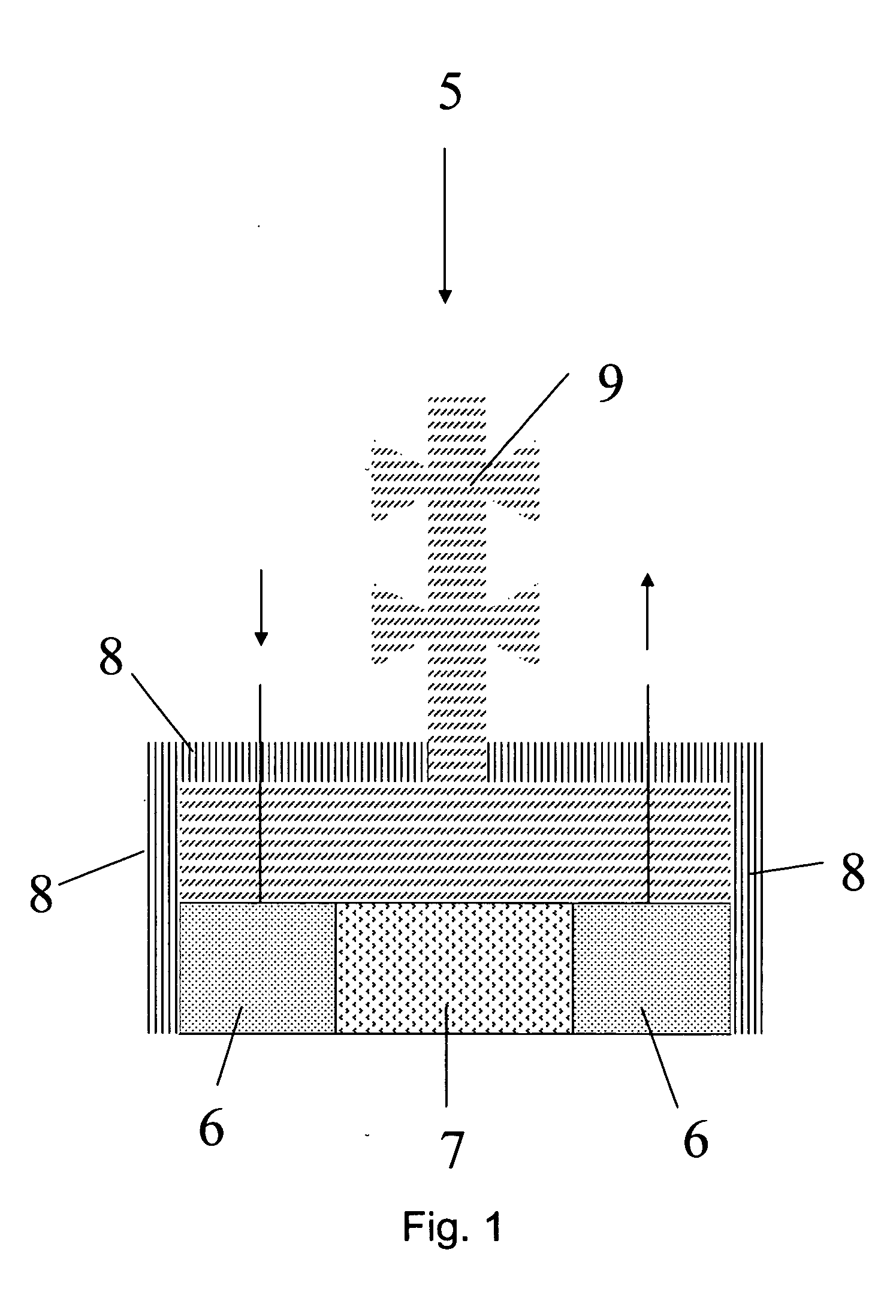Method and apparatus for electromagnetic modification of brain activity
- Summary
- Abstract
- Description
- Claims
- Application Information
AI Technical Summary
Benefits of technology
Problems solved by technology
Method used
Image
Examples
example 1
[0174]FIG. 20:
[0175] D 2000 (Behavioral Target):
[0176] Amplification of positive emotions for the duration of the application
[0177] D 3000 (Behavioral Model):
[0178] The following correspondence is called “reduced Davidson-model” (see e.g. [11]): positive emotions correspond to a higher quotient of beta to alpha activity in the left-frontal cortex (beta=13-30 Hz, alpha=8-12 Hz).
[0179] S 500 (BAI Specification and Calculation, Specification of Target BAI-Dynamics):
[0180] The Davidson-model is based on the power-spectrum of EEG-signals. A suitable BAI is therefore a sequence of squared moduli of Fourier coefficients, to be calculated via Fast Fourier Transformation, for example for frequencies between 1 and 50 Hz. Derived BAI is Pos:=∑i=1330fi2 / ∑i=812fi2
[0181] (Assumption: only integer frequencies, Fourier-window e.g. 500 milliseconds, fi modulus of the Fourier coefficient of the i-Hertz-mode. To cover the frequencies from 1 to 50 Hz, according to Nyquist at least 100 data po...
example 2
(Steps Will Be Explained Only in Extracts):
[0380]FIG. 20:
[0381] D 2000 (Behavioral Target):
[0382] Amplification of positive and reduction of negative emotions for the duration of the application
[0383] D 3000 (Behavioral Model):
[0384] Davidson-model (see e.g. [11]): positive emotions correspond to a higher quotient of beta to alpha activity in the left-frontal cortex (beta=13-30 Hz, alpha=8-12 Hz), negative emotions correspond to a higher quotient of beta to alpha activity in the right-frontal cortex.
[0385] S 500 (Specify BAI, Specify Target BAI Dynamics):
[0386] In analogy to example 1. Derived BAI are Pos:=∑i=1330fi,12 / ∑i=812fi,12
for one left-frontal sensor S1, and for Neg:=∑i=1330fi,22 / ∑i=812fi,22
a right-frontal sensor S2. (fij coefficient of the i-Hertz mode of the sensor j). Pos shall be increased, e.g. Pos(t, with influence)>2*Pos(t, without influence). Neg shall be decreased, e.g. Neg(t, with influence)>0.5*Neg(t, without influence). These requirements determin...
example 3
[0443] Example 3 shall not be presented as comprehensively as the previous examples (e.g. all modes, local calibration of all sensor-transmitter-pairs, etc), but shall mainly highlight essential differences with respect to the previous examples.
[0444]FIG. 20:
[0445] D 2000 (Behavioral Target):
[0446] Prolongation of focused attention on mental activities for the duration of the application.
[0447] D 3000 (Behavioral Model):
[0448] Based on e.g. [20] and [21]), FmΘ(frontal midline theta), i.e. 6-7 Hz activity in the vicinity of the Fz-electrode (see [16]), corresponds to focused attention on mental activities. This fact shall in the following be called Ishihara-Yoshii-model.
[0449] Neurons near the cranium, within the detection range of the Fz-sensor, are directly connected with some other areas, in particular subcortical driving was detected. The power spectrum is calculated as before. Instead of Pos and Neg there is now for each sensor Att:=∑i=67fi2 / ∑i=8maxfi2 (max=50).
[0450...
PUM
 Login to View More
Login to View More Abstract
Description
Claims
Application Information
 Login to View More
Login to View More - R&D
- Intellectual Property
- Life Sciences
- Materials
- Tech Scout
- Unparalleled Data Quality
- Higher Quality Content
- 60% Fewer Hallucinations
Browse by: Latest US Patents, China's latest patents, Technical Efficacy Thesaurus, Application Domain, Technology Topic, Popular Technical Reports.
© 2025 PatSnap. All rights reserved.Legal|Privacy policy|Modern Slavery Act Transparency Statement|Sitemap|About US| Contact US: help@patsnap.com



